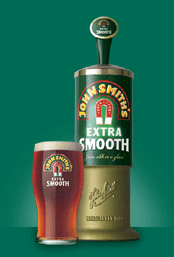Heineken have managed to save themselves £6.6 million a year in beer duty while at the same time gaining brownie points by going with the flow of the government-approved programme of taking alcohol units out of the market. It still isn’t out of line with its competitors – Greene King IPA is 3.6%, and I believe smoothflow Boddingtons is only 3.5% – but this is a clear indication of the overall direction of travel. And don’t forget that some popular Scottish smooth beers such as Belhaven Best and Caledonia Best are a mere 3.2%, so there may well be further to go. In the long term, beer strength reductions are an inevitable result of the duty escalator.
Cask John Smith’s Bitter will remain at 3.8%, so there may be a temptation to say “I’m all right Jack.” However, we have already seen strength reductions for many popular cask brands such as Bombardier and Old Speckled Hen and, while there remains a wide mix of strengths in the market, I certainly get the impression that the average strength of guest beers offered in pubs has significantly fallen in recent years. And it’s not inconceivable that, for example, Robinson’s might decide that they gain no benefit from brewing Unicorn at 4.2%, which is a couple of points stronger than any of its direct competitors.
Of course, given that in some quarters it is portrayed as a virtue that beer is a “low-strength drink”, this could be regarded as good news in advancing the responsible drinking agenda.










John Smiths Extra Smooth watered down. In the words of Rhett Butler, "Frankly, my dear, I don't give a damn."
ReplyDeleteOr with apologies to Marie Antoinette, "Let them drink Tetleys!"
I've had it a few times. Its a bit similar to drinking Green King IPA or any other low quality bitter through a sparkler.
ReplyDeleteGreene King IPA is such a let-down, it used to be a decent beer way back in the 80's. Now it's just something to be avoided.
ReplyDeleteCrikey, what is this? The Happy Version of Tandy's blog?
ReplyDeleteFar from the argument of whether this is a "good thing" or a "bad thing" ... has no one picked up on the point that Heineken will avoid some £6.6 millions in duty whilst upping the wholesale price by 2.5p a pint?
ReplyDeleteYet again hard pressed publicans and the consumer will pick up the tab for this change and publicans will feel the heat especially as ill-informed consumers blame them for watering down the beer and "profiteering" by having to charge, probably, 5p a pint more for an inferior product.
In their defence, as part of their annual price increase they're upping the price of other beers that haven't had a strength reduction by 5p a pint.
ReplyDeletesorry, happy shopper version... duhhh
ReplyDeleteThe question is whether loyal customers to the brand will accept the change or abandon it. Who knows?
All I know is that it is a more popular product than most beer geeks, enthusiasts, bloggers, camra types believe. It is ubiquitious in clubland and mainstream keg only pubs. It appears the default keg bitter of the land in much the way Carling is the default lager. It appears more an on trade than an off trade brand. Whilst cooking lagers have become supermarket beers piled high, this one is no more on special in Tesco than other bitters.
As a product it is advertised to middle aged men. 20 years ago nitro brands like Boddies were advertised to young men. Beer adverts to young men are now rarely anything but cooking lager.
Time will tell whether brand goes the way of Boddies and is seen only on a shelf in Tesco and has you thinking “Good god I didn’t know they still made it”. If so I doubt the customers will rush to vinegary filth.
Isn't Boddingtons now the strength it was in 1970? It was always one of the weaker beers. This reminds me of Colorado in 1982. 18 year olds were then allowed to buy "three-two" beer - 3.2% by weight, 3.5% by volume. I think most US drinking ages have now reverted to 21 for any drink. Recent figures show 18 year olds still get hammered regularly.
ReplyDeleteThe old Boddingtons only had an original gravity of 1035, but was very thoroughly attenuated and so achieved an ABV of more like 4.0%, which was one of the reasons for its popularity. This also made it very dry. At that time beer duty was worked out by OG rather than ABV.
ReplyDeleteThanks Curm. I have been under a misapprension all these years - possibly because, when kept well, it gave me less of a hangover than other beers.
ReplyDeletePutting aside the reasons for it, I'd actually be quite happy to see cask ales around 3% - 3.5% becoming much more widespread - there's not enough around at the moment.
ReplyDeletePlenty of cask Robinson's 1892 in and around Stockport :-)
ReplyDeleteEye, but Robbies is a 50/50 gamble in stuckpit. For sure the beard club gong winning pubs are decent enough but the rest are shit holes. A pint of smooth may be a bit naff but it goes down easier than Sarsons best.
ReplyDelete